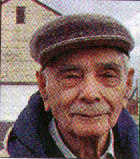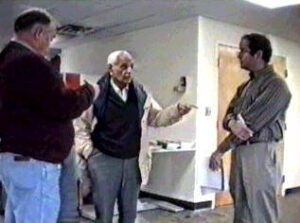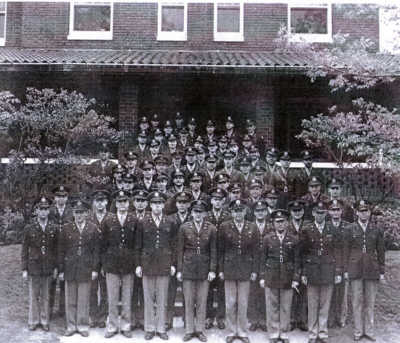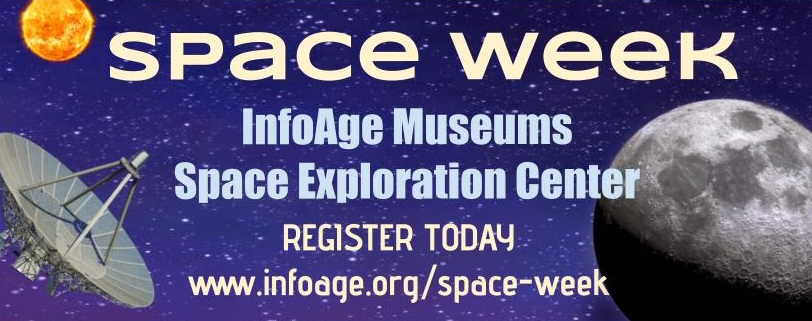The History of InfoAge Science & History Museums
Oral Histories - Pioneer returns to Camp Evans Engineer helped develop radarBy James A. Broderick, Correspondent, Asbury Park Press, Monday, January 11, 1999
John Marchetti, 90, Cherry Hill, was one of a small group of scientists who labored at Camp Evans in a top-secret laboratory during the 1930s and ’40s on electronic equipment that not only affected the course of the war but would find many peacetimes uses
Wall – The Japanese attack on Pearl Harbor, Dec. 7, 1941, which brought the U.S. into World War II, could have had an entirely different outcome had the defenders made proper, use of a unique electronic device they had at their disposal.
That’s one of the disclosures made Saturday by one of the scientists who developed that very versatile equipment, which would change forever the conduct of warfare and many peaceful pursuits — radar, an acronym for radio detecting and ranging.
John Marchetti, 90, Cherry Hill, was one of a small group of scientists who labored at Camp Evans in a top-secret laboratory during the 1930s and ’40s on electronic equipment that not only affected the course of the war but would find many peacetimes uses. Marchetti came to Camp Evans in 1937 as a junior radio engineer, shortly after completing his graduate studies at Columbia University, N.Y., in electronic engineering. Marchetti was here being interviewed for a “living history” of the post by Fred Carl, Wall, who is leading a fund-raising campaign to restore some of the camp’s permanent buildings such as the “Marconi Hotel,” the brick structure facing, Marconi Road where the wartime scientists worked.
Carl hopes to convert the historic site to a “hands-on” electronics education center for area youths. Marchetti said he was “furious” when he learned of the Pearl Harbor debacle which, in addition to the death and destruction it caused, seriously, crippled the Navy’s Pacific Fleet for many months to come. What was disturbing to him, Marchetti said, was the later disclosure that U.S. Air Corps Radar operators had detected the incoming Japanese aircraft when it was still some 200 miles out and reported that fact up through the chain of command.
That would have given the defenders more than an hour to react to the impending strike, he said, sufficient time to scramble U.S. fighter aircraft from island bases to intercept, and ample enough for the activation of the substantial ship and ground-based anti-aircraft defenses. Why the warning never got to the high command is not known. The result was the destruction of most of the U.S. aircraft on the island and serious damage to the fleet.
Had the U.S. Forces deployed, Marchetti said, they would have had a better than even, the chance of destroying the Japanese and thus changing the entire subsequent course of the war, especially in the Pacific Theater.
Marchetti said the radar in Hawaii at the time was the SCR-270 100 megacycle set, developed by his team at Camp Evans, under the command of Maj. Paul Watson, another of the pioneers.
Shortly after the start of the war, Marchetti said he and the other scientists were “furloughed to the service.” He became a captain in command of a company. During this service, he said, he traveled throughout the world, providing electronic assistance to virtually every U.S. service component and some to Allied forces. He helped British radar operators to better detect incoming German V-1 jet-propelled “buzz bombs,” increasing the anti-aircraft kill ratio for the destructive bombs from 0 to 85 percent.
Later, in Europe and in the Pacific area, he said he helped developed radars to quickly detect enemy mortar positions which were causing many casualties among U.S. personnel. After his discharge from the Army, Marchetti served as technical director of Radio and Physics Research at the U.S. Air Force Cambridge Research Center in Mass. Resigning from government service in 1954, Marchetti went into private industry as an electronics consultant.
page created February 27, 2000
Additional information
 On January 9, 1999, Mr. Marchetti returned to Camp Evans to provide an oral history for our research and archives. He was with his daughter Mrs. Nina Archabal. This gentleman’s accomplishments are documented in many books and many a WWII G.I. is alive today thanks to his radar expertise and leadership.
On January 9, 1999, Mr. Marchetti returned to Camp Evans to provide an oral history for our research and archives. He was with his daughter Mrs. Nina Archabal. This gentleman’s accomplishments are documented in many books and many a WWII G.I. is alive today thanks to his radar expertise and leadership.
Mr. Marchetti stood during the entire hour interview. Answering question after question as if the events occurred last week. A few months after this interview Mr. Marchetti was awarded a medal from France for his participation in D-Day and the liberation of France. He adds this to the prestigious ‘Order of the British Empire’ award from England for his anti-V1 and V2 radar work. Mr. Marchetti (left) is in front of building 9020 where he and twenty others assembled the radar kits for the world’s first mortar locating radar during WWII.
Web editors note: Dr. Marchetti started his career in 1937 at main post-Fort Monmouth, then was instrumental in the radar development at Fort Hancock, Sandy Hook, NJ. His work at Camp Evans was done in 1941 and later.
 Dr. Marchetti related another story from Fort Hancock. He was working with his team in the hot summer sun in his undershirt. He was a “hands-on” and take charge person. A visiting officer came by to observe the progress who proceeded to lecture Dr. Marchetti on the proper military dress for officers and how he show assigns the work and not be in the middle of it. Dr. Marchetti politely reminded the officer a war was coming and dress code or not they would all be in the middle of it.
Dr. Marchetti related another story from Fort Hancock. He was working with his team in the hot summer sun in his undershirt. He was a “hands-on” and take charge person. A visiting officer came by to observe the progress who proceeded to lecture Dr. Marchetti on the proper military dress for officers and how he show assigns the work and not be in the middle of it. Dr. Marchetti politely reminded the officer a war was coming and dress code or not they would all be in the middle of it.
The radar pioneers in front of the Marconi hotel during WWII. Left to right in the front row:
#2 Harold Zahl, made vacuum tubes VT158 for AN/TPS3 radar
#4 Jack Slattery, designer of SCR268 fire control radar
#5 Oscar Maier, commanding officer
#6 Paul Watson, technical director, John Marchetti’s boss
Mr. Marchetti is the last person in the third row whose head is even with the white trim on the porch
(photo and identification courtesy of Mr. John Marchetti)

The radar pioneers in front of the Marconi hotel during WWII. Left to right in front row: #2 Harold Zahl, made vacuum tubes VT158 for AN/TPS3 radar #4 Jack Slattery, designer of SCR268 fire control radar #5 Oscar Maier, commanding officer #6 Paul Watson, technical director, John Marchetti’s boss Mr. Marchetti is the last person in third row whose head is even with the white trim on porch (photo and identification courtesy of Mr. John Marchetti)
References related to Mr. Marchetti:
Electrons Away, by Harold Zahl Pg. 72
Radar Spelled Backwards by Harold Zahl Pg. 84-89
U.S. Army in WWII, The Signal Corps: The Outcome by G. R. Thompson Pg. 505-506
Dr. Marchetti passed away in 2003
In December 2005 Fort Monmouth’s, Melissa Ziobro of C-E LCMC Historical Office transcribed our entire interview. Thank you, Melissa!! It is now on file in the InfoAge Archives.
Thanks to Bob Buderi author of
The Invention That Changed The World – How a Small Group of RADAR Pioneers Won the Second World War and Launched a Technological Revolution The Sloan Technology Series for introducing us to Dr. Marchetti
1996 Simon and Schuster
ISBN: 0-684-81021-2
We Need Your Help! Volunteer with Us.
Join our mission to preserve historic Camp Evans and teach the public about science and history.
Sign up to join our team of volunteers and start on your own mission today.
InfoAge Science & History Museums
2201 Marconi Road
Wall, NJ 07719
Tel: 732-280-3000
info@infoage.org
webmaster@infoage.org

